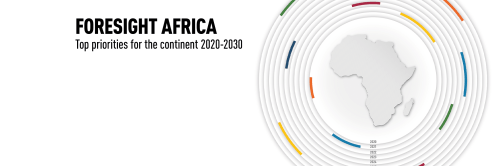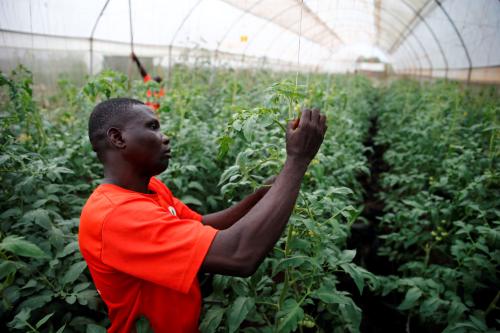Below is a Viewpoint from Chapter 4 of the Foresight Africa 2020 report, which explores six overarching themes that provide opportunities for Africa to overcome its obstacles and spur inclusive growth. Read the full chapter on combating climate change.
Climate change will undoubtedly present one of the most significant risks to Africa’s sustainable development objectives over the next decade, and nowhere is the threat more imminent than on its coastlines. Indeed, recent estimates show that sea levels could rise 100 cm by 2100, further compounding the many hazards threatening the region.
Particularly worrisome is that demographic trends are interacting with climate change in coastal areas, generating a unique set of development challenges. Coastal areas in Africa, like elsewhere in the world, tend to be more densely populated due to the economic opportunities there. For example, in Nigeria’s low-elevation coastal zones (LECZs, areas located 10 meters or less above mean sea level), the population density is 491 inhabitants per km2, compared with 134 inhabitants per km2 nationally. By some estimates, Africa’s populations in LECZs will rise at an annual rate of 3.3 percent between 2000-2030, which is more than double the world’s average. In many cases, individual countries will experience even more extreme changes: For example, in Senegal, the share of the LECZ population is projected to skyrocket to 50 percent by 2060, up from 20 percent in the early 2000s.
As sea levels rise, so too does the likelihood that the success of these burgeoning regions will be washed away as food production will decrease, access to clean water will be curtailed, catastrophic storms will become more prevalent and more harmful, acidification will spread, and the region’s already limited ability to mitigate these and related disasters will falter.
Extreme weather events will become less predictable and more damaging
By substantially increasing sea surface temperature, climate change brings about more violent cyclone activity and storm surges on coastlines, generating higher wind speeds and heavier precipitation, which make disaster forecasting, preparedness, and management more challenging. Indeed, an increase in the temperature of tropical sea surface by 1°C increases wind speed by 3 to 5 percent.
About 30 million Africans live within the flood hazard zone around the Atlantic and Indian Oceans, out of which 2 million are likely to be flooded each year. Abidjan is a case in point: It is ranked among the world’s top 20 cities in term of population exposure to floods, and its asset exposure is similarly high at $42 billion.
Natural defenses to extreme events will erode
Mangroves offer an effective buffer against coastal vulnerability to storm surges by obstructing the flow of water and hence attenuating inundation. Therefore, they can play the same role as infrastructure designed to protect coastal areas from such extreme events as storm surges and cyclones. Notably, mangrove rehabilitation projects can be two to six times cheaper than other protection infrastructure. However, mangroves have varying tolerance to salinity, depending on the species. Flooding, deforestation, and increases in ocean surface temperature that raise the salinity of inland water are increasingly putting mangroves in jeopardy and further weakening the already fragile adaptive capacity of African coastlines. According to some estimates, vulnerable populations exposed to the risk of mangrove destruction are projected to increase by 103 percent and losses in GDP by 233 percent from the baseline scenario.
Increased salinity will cause clean water availability to dry up and infrastructure to falter
Beyond its damaging effects on mangroves, saltwater intrusion into inland coastal areas negatively impacts river salinity, hence available drinking and irrigation water, making both offseason agriculture and freshwater fishing more challenging. Saline water intrusion into inland water also increases the risk of high blood pressure in pregnant women and increases infant mortality. Africa’s already weak infrastructure will also suffer, as salinity stemming from sea-level rise impacts roads through land subsidence, progressive blistering, cracking, and pulverization, resulting in higher maintenance costs.
Food production will suffer
In Africa, artisanal fishing is a predominant economic activity. For example, in Ghana, 2.2 million people depend on fishing for their livelihoods, including nearly 125,000 artisanal fishermen. Rises in water temperature and acidification levels damage many fish species’ physiology, including their size and reproductive capacity, and, therefore, their market value. Relatedly, changes in water temperature cause species to migrate and diminish the number and size of catches. Indeed, local fishermen in West Africa have, in recent years, reported that some types of previously abundant fish are increasingly scarce, even disappearing. For example, the sardinella fish species, which used to be highly abundant in Senegalese sea waters have now disappeared.
Strategies for adaptation and financing
Adaptation is paramount for withstanding the effects of climate change, especially since inaction will be costlier. Estimates show that adaptation costs range from less than 5 percent (in Niger) to 60 percent (in Kenya) of the costs of inaction. Crucial strategies for adaptation include infrastructure construction and maintenance, beach nourishment, and diversification away from activities vulnerable to climate change. If governments undertake some of these strategies, population exposed to flooding could be halved by 2100. Without adaptation, the annual costs related to flooding alone could range between $5 billion and $9 billion.
A key challenge to the implementation of adaptation strategies in Africa is financing. Costs of adequate adaptation could reach $300 billion for Africa, plus $3 billion per year for maintenance—numbers that sharply contrast with the limited resources currently devoted to adaptation in Africa. While developed countries have pledged to double funding for adaptation projects over the 2014-2020 period, the cumulative funding flowing to developing counties reached only $4.4 billion in 2018, with around 43 percent of this amount going to Africa. Scaling up financing to adaptation is critical to avoid further disrupting already fragile economic and social infrastructure. Notably, financing adaptation must not use the same pipeline and modalities as standard official development assistance. So far, climate funding is highly unpredictable and depends solely on the good will of donor countries. Considering the increasingly robust scientific evidence linking levels of emission to economic losses, health, peace, and security in Africa, the “polluter pays” principle should be used to channel funds for adaptation financing in African countries. This funding should be specifically earmarked to climate change-related projects to ensure that investments are fast-tracked, and that disaster responses are timely and effective.
The Brookings Institution is committed to quality, independence, and impact.
We are supported by a diverse array of funders. In line with our values and policies, each Brookings publication represents the sole views of its author(s).










Commentary
Confronting the challenges of climate change on Africa’s coastal areas
January 16, 2020